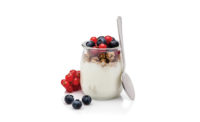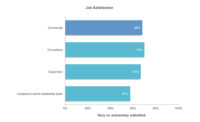The California Milk Advisory Board released a study that highlights the dairy industry’s impact on California’s economy, including the number of jobs and revenue generated from a typical dairy farm in one year. In 2008, the latest year for which figures are available, California’s largest agriculture commodity was responsible for creating a total of 443,574 jobs and $63 billion in economic activity for the state.
The typical California dairy cow and farm stimulates a positive ripple effect throughout the state, according to the research conducted by J/D/G Consulting Inc., an independent dairy industry research firm based in Florida. Specifically, a typical dairy farm in California generates $33.1 million in economic activity and 232 jobs in the state, including “on-the-farm” and “beyond-the-farm” jobs like milk tanker drivers, grocery store clerks, feed farmers and employees at milk processing and cheese plants, among others.
When compared to the impact of other notable California industries, the dairy industry provides more economic stimulus and jobs to the state yearly than either the iconic motion picture/television or wine industries. The most recent statistics available for these industries show that the motion picture/television industry contributes $35 billion and 208,230 jobs (2007) and the wine industry provides $59 billion and 330,000 jobs (2008).
“This research offers a perspective on how vital the dairy industry is to California with every dollar from production and sales of California milk contributing to the economy,” said Stan G. Andre, chief executive officer of the CMAB. “In addition to providing one of the four food groups that feeds our local communities, a typical dairy cow generates more than $34,000 in economic activity and a herd of 100 cows creates 25 jobs for California residents each year.”
And they’re doing so in a sustainable manner. California’s dairy producers are subject to the most stringent environmental regulations in the United States. In 1997, the industry partnered with governmental agencies and academia to create the California Dairy Quality Assurance Program, a voluntary partnership providing education and resources for dairy producers to navigate and comply with the state’s myriad environmental regulations as well as providing information on animal health and welfare, food safety and emergency preparedness. The program was recognized with California’s highest and most prestigious environmental honor, the Governor’s Environmental and Economic Leadership Award and is considered a model of how an industry can work in partnership with governmental agencies for the betterment of the environment.
California is Nation’s Dairy Leader
California’s dairy families were responsible for producing more than 41 billion pounds of milk in 2008, a figure that is expected to exceed 46 billion pounds by 2020.
According to the study, in 2008 California had 1,905 dairies with 1.8 million dairy cows that supplied milk to 117 dairy processing plants, which produced cheese, fluid milk, ice cream, butter and other dairy products that carry the Real California Milk and Real California Cheese seals. These seals help consumers identify dairy products made with milk from California dairy farms. Since the introduction of the Real California Milk seal in 2007, awareness of and purchase intent for California dairy products has increased significantly.
California’s dairy industry is comprised of dairy families, many who have been in the business for generations. To give consumers a better understanding of the people behind Real California dairy products, the CMAB developed 15 mini-documentaries profiling California dairy families that are available online at www.RealCaliforniaMilk.com/people.
California Dairy Production Highlights
Following highlights from the study show California’s continued leadership in dairy production:
· The California dairy industry created 443,574 jobs in 2008 accounting for approximately 3% of the jobs in the state. This is more than either the iconic California wine or motion picture/television industries.
· California’s dairy industry generated $63 billion in economic impact in 2008 as compared to $61.4 billion in 2007, a 2.6% increase overall.
· The typical California dairy farm in 2008 generated $33.1 million in economic activity and produced 21,869,370 pounds of milk, an increase of more than nine million pounds since 1998.
· The typical California cow in 2008 generated $34,165 of economic activity and produced 22,344 pounds of milk.
· California’s total milk production has grown from 27.6 billion pounds in 1998 to 41.2 billion pounds in 2008.
Study Methodology
This analysis of the California dairy business relies on numerous sources of published data that measure various aspects of milk production, dairy product production, dairy food distribution, grocery retailing and foodservice businesses. It also uses economic output, earnings and employment multipliers developed by the U.S. Department of Commerce, Bureau of Economic Analysis. BEA-developed multipliers are provided for a host of industries, including milk production/dairy farming and dairy processing/manufacturing for each state.
The same study last conducted in 2007 showed California dairies created $61 billion in economic activity and 435,000 jobs for the state.
About the California Milk Advisory Board
The California Milk Advisory Board, an instrumentality of the California Department of Food and Agriculture, is funded by the state’s 1,700 dairy families. With headquarters in South San Francisco and Modesto, the CMAB is one of the largest commodity boards in the United States. The CMAB executes advertising, public relations, research and retail and foodservice promotional programs on behalf of California dairy products, including Real California Milk and Real California Cheese. For more information on California dairy products, visit www.RealCaliforniaMilk.com.
Get our new eMagazine delivered to your inbox every month.
Stay in the know on the latest dairy industry trends.
SUBSCRIBE TODAYCopyright ©2024. All Rights Reserved BNP Media.
Design, CMS, Hosting & Web Development :: ePublishing


